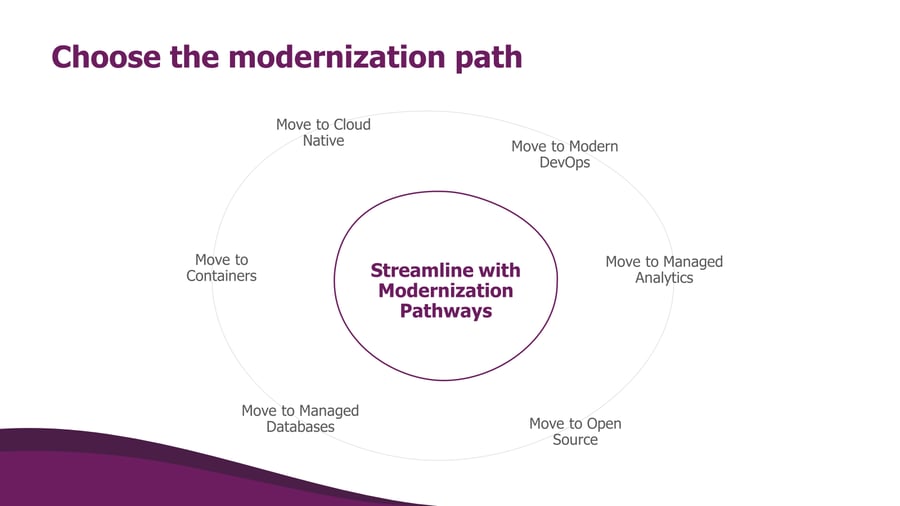How cloud modernization contributes to green business transformation
Cloud modernization is usually defined as updating or upgrading applications to take full advantage of cloud-native services. Today’s challenge is not just to reduce cost and operational overhead by moving to the cloud but to integrate the sustainability paradigm into the business DNA. At AWS, they are not just meeting the “go green” requirements but exceeding them, providing platforms, services, and processes for achieving ecological balance.
Introduction
Business applications are the engines that help run one company. Keeping them up to date from technical and business aspects is crucial for reducing TCO, releasing resources, and shifting focus on the company's core mission.
Many companies started their journey to the cloud by migrating from on-premise. AWS provides powerful migration strategies based on company needs where, with deployments to AWS, companies can reduce payback periods to 6 months and reduce total cost of ownership (TCO) by 64%.
The cloud modernization process, to some level, is a continuation of migration processes. While some migration strategies, like Retire or Retain, do not require a long-lasting team effort, others, like Relocate, Rehost, Refactor, Repurchase, and Replatform, have many challenges. So, making the right decision is important as it comes with high-impact consequences.
The common challenges that teams face during the migration process are:
- Long and complex analyses (analysis paralysis) that postpone the process of implementation.
- Complex monolithic applications, applications without proper documentation where the development team is unavailable, or applications that are difficult to understand.
- Lacking the skill sets required to modernize applications with microservices, containerization, and DevOps cloud technologies.
- Organizational silos – lack of correct communication, point of contact, process owners, etc.
To overcome the challenges, modernization is a process that combines architecture, technologies, software delivery, and operational practices and enables teams to focus on software quality, building new skills, innovation, and business added value.
Xebia modernization approach
The Xebia team can accelerate the modernization process by applying our expertise and tailor-made building solutions with a personal approach, reducing the time to cloud. Our approach is unique as we take GreenOps findings and embed them in a starting point for the modernization journey.
In our two-week-long modernization program, we:
- Assess the current system’s state combined with GreenOps findings and proposals, setting up priorities and choosing the right application/workload candidate for modernization.
- Architect the solution by selecting one or a combination of the AWS 6 modernization pathways.
- Build the solution, closely involving the focus group from the customer’s team.
- Deploy the final solution as MVP, along with detailed documentation.

Customers can validate the benefits from day one, when the GreenOps program starts, by having a granular overview of the cloud landscape and usage. In the first workshop, those findings are combined with business needs during the assessment phase. The outcomes are: focus group and program owners, application/workload modernization candidates, implementation expectations, and learning programs.
Discover our Whitepaper: Harnessing Digital Transformation for ESG Goals and Carbon Reduction
During the build and deploy phase, the Xebia team prepares and delivers high-level architecture and design, MVP, implementation steps documentation, and knowledge transfer strategy. With the customer's focus team, we deploy the solution in the customer's environment, walking through the development, build, and deployment process. The expectation is that the customer's focus team will gain valuable knowledge, be ready to take ownership of the solution, and continue to build on top of it.
GreenOps reports
GreenOps is a cloud operating model that encapsulates all the efforts made by the cloud user to reduce the carbon footprint of the resources running on the cloud. When optimizing a customer's environment for costs, we can also consider the necessary measures to visualize and reduce the emissions of customer workloads.
Xebia’s Cloud Sustainability approach includes:
- Providing visibility: Gather, calculate, estimate, and assimilate carbon emission equivalents your cloud usage produces.
- Understanding and communicating the footprint.
- Reporting on the emissions.
- Optimizing the workloads.
GreenOps reports provide a valuable and unique data perspective that sets the direction of modernization.
Modernization pathways
Xebia’s modernization program follows the six ModAx pathways:

Xebia has developed a unique approach for each path, leveraging the concepts behind the path. For example, we explore if a customer has a monolithic application(s) or application that needs to extend capabilities or improve adaptability and scalability. We detect the concept for the solution: domain-driven design, event-based architecture, microservices, data autonomy, etc. Based on the concept(s), we start with blueprints tailored to customer needs, such as distributed processing, enterprise service bus, integration endpoint, etc.
|
When |
Concept |
AWS Services |
Blueprints |
|
Monolith application Extend capabilities of current application Improve adaptability and scalability |
Domain Driven Design Microservices Event-based architecture Data autonomy Iterative modernization with Strangler Fig pattern Serverless
|
AWS Lambda AWS API Gateway AWS ECS AWS EKS AWS Migration Hub Refactor Spaces AWS EventBridge AWS SQS AWS SNS |
Expose or consume data
Enterprise service bus
Distributed systems |
Contribute to green business transformation
Xebia’s modernization program connects people and technology along assessment, architecture, building, and deployment phases through workshops and knowledge transfer sessions. How does modernization contribute back to green business transformation?
During the architecture and design process, choosing the right modernization path and services for implementation of the concepts, Xebia is highly dedicated to choosing and providing the right compute size for workloads, optimizing compute and memory consumption, implementing retention and lifecycle policies for data, use Graviton processor-based containers and functions, move to managed databases and optimize backup processes, implement orchestration services for dynamic scaling, etc.
Consistent decisions are made towards grasping the benefits of the cloud, ultimately achieving the sustainability goals, and keeping the green business transformation in motion.





